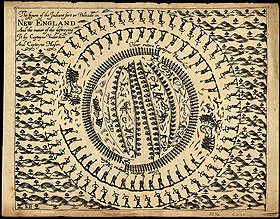  |
| HOME | THIS ISSUE | CALENDAR | PATENTS | BACK ISSUES | < BACK | NEXT > |
Researchers seek to identify Pequot War battlefield sites by Sherry Fisher - November 10, 2008 | ||||
| The Pequot War, a conflict between English settlers and the Pequot tribe, is the focus of a new comprehensive study by a team of UConn researchers. Kevin McBride, associate professor of anthropology in the College of Liberal Arts and Sciences (CLAS), says the war, which took place from 1636 to 1638 in southern New England, remains one of the most misinterpreted and least understood events in the history of early America. McBride is working on the project with Connecticut State Historian Walter Woodward, assistant professor of history in CLAS, State Archaeologist Nick Bellantoni, and the Mashantucket Pequot Museum and Research Center. Funded by the National Park Service American Battlefield Protection Program, the project aims to identify and preserve battlefields and historical sites associated with the Pequot War. “The English wanted to eliminate the powerful Pequot,” says McBride. “It was the first time a policy of cultural genocide was perpetuated upon a native people in North America. The English justified what they did through a variety of means, including vilifying the Pequot and making them evil.” But although the English tried to wipe out the Pequot tribe, two communities survived and are known today as the Mashantucket Pequot and the Eastern Pawcatuck Pequot tribes. “The war was far more than the single attack by the English and their Mohegan and Narragansett allies on the tribe’s fortified village at Mystic in 1637,” McBride says. Lasting for more than two years, there were several major battles and skirmishes that extended over what is now southwestern Rhode Island, coastal Connecticut, the Connecticut River Valley, northeastern Connecticut, and parts of eastern New York. The war changed the political and social landscape of southern New England, he says: “The massacre at Mystic Fort, as was the English intent, demonstrated to all native people in southern New England and elsewhere, the English ability and will to wage total war against real and imagined enemies.” The early phases of the research include identifying and analyzing narratives, accounts, and descriptions of the war, a review of scholarly and antiquarian works, an analysis of military strategies, and an analysis of artifacts.
About a dozen prospective battlefield sites have already been identified. The researchers will also search for physical evidence through archaeological investigations. McBride says that documents from commanders in the war have provided information about battlefield locations. “It’s taken a lot of analysis to figure out where these battlefields are,” he says. The researchers are now in the process of notifying and talking to land owners to get permission to conduct archaeological investigations on their property. The Pequot War was taught in American history books throughout the 19th century, but is not often studied outside academic circles, McBride says. He notes that that the conflict provides a rich source of information about a particular time in history. “We don’t know that much about the early colonial history of the region of southern New England,” he says, “and the war is an incredible window into that.” He adds, “We took the opportunity through this grant to explore many aspects of the Pequot War. We initially looked at this as a one-year grant process and now we’re looking at probably four to five years. It’s a pretty extensive piece of work.” The war lives on in the memories of the descendants of the colonists and native peoples of southern New England, McBride says: Each year members of the Pequot Tribe gather on the anniversary of the Mystic Massacre for a “First Light” ceremony to commemorate and honor the more than 500 Pequot men, women, and children who were massacred at the Mystic Fort on June 11, 1637. |
| ADVANCE HOME UCONN HOME |

